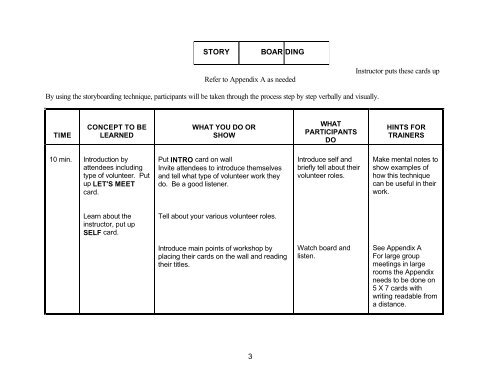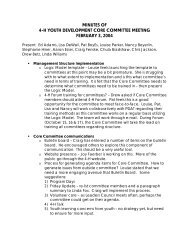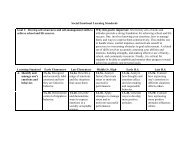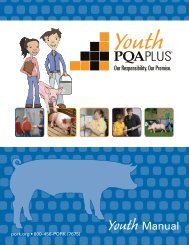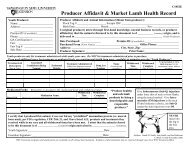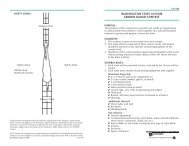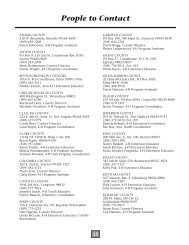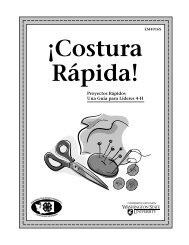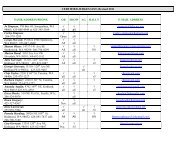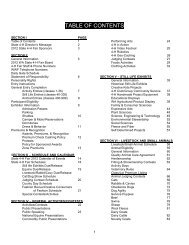Storyboarding - 4-H Youth Development Program
Storyboarding - 4-H Youth Development Program
Storyboarding - 4-H Youth Development Program
Create successful ePaper yourself
Turn your PDF publications into a flip-book with our unique Google optimized e-Paper software.
Refer to Appendix A as needed<br />
By using the storyboarding technique, participants will be taken through the process step by step verbally and visually.<br />
TIME<br />
CONCEPT TO BE<br />
LEARNED<br />
10 min. Introduction by<br />
attendees including<br />
type of volunteer. Put<br />
up LET'S MEET<br />
card.<br />
Learn about the<br />
instructor, put up<br />
SELF card.<br />
STORY<br />
WHAT YOU DO OR<br />
SHOW<br />
Put INTRO card on wall<br />
Invite attendees to introduce themselves<br />
and tell what type of volunteer work they<br />
do. Be a good listener.<br />
Tell about your various volunteer roles.<br />
3<br />
BOAR DING<br />
Introduce main points of workshop by<br />
placing their cards on the wall and reading<br />
their titles.<br />
WHAT<br />
PARTICIPANTS<br />
DO<br />
Introduce self and<br />
briefly tell about their<br />
volunteer roles.<br />
Watch board and<br />
listen.<br />
Instructor puts these cards up<br />
HINTS FOR<br />
TRAINERS<br />
Make mental notes to<br />
show examples of<br />
how this technique<br />
can be useful in their<br />
work.<br />
See Appendix A<br />
For large group<br />
meetings in large<br />
rooms the Appendix<br />
needs to be done on<br />
5 X 7 cards with<br />
writing readable from<br />
a distance.
TIME<br />
CONCEPT TO BE<br />
LEARNED<br />
5 min. History and<br />
background<br />
information on the<br />
process. Put up<br />
DISNEY card.<br />
Put up THINK TANK<br />
card.<br />
WHAT YOU DO OR<br />
SHOW<br />
Put up BACKGROUND card. "In the early<br />
years of animation, Walt Disney and his<br />
creative artists used the storyboarding<br />
technique to lay out or plan all cartoons.<br />
Each artist or writer contributing an idea<br />
per card used entire rooms with nothing on<br />
the walls to plan story lines. Cards were<br />
placed on the wall in various places<br />
depending on if they were main ideas,<br />
plots, or details of the plot (taking position<br />
under the main idea).<br />
During this process everyone was free to<br />
place their cards or ideas anywhere along<br />
the walls, remove cards, or move cards to<br />
other areas."<br />
"This new concept proved to be a quick<br />
and creative way to produce cartoons and<br />
Disney later taught his entire staff to use<br />
the process. Not only are cartoons and<br />
movies planned by this process, but also<br />
Disneyland and Disney World."<br />
"<strong>Storyboarding</strong> became so popular that<br />
Disney began an early version of think<br />
tanks called 'Imaginary, Inc.' applying the<br />
process to many problems and teaching it<br />
to Fortune 500 companies."<br />
4<br />
WHAT<br />
PARTICIPANTS<br />
DO<br />
Watch as cards are<br />
put in place on the<br />
wall building a<br />
storyboard.<br />
Visualize a room full<br />
of ideas and how<br />
people interchange<br />
and build on idea<br />
cards.<br />
HINTS FOR<br />
TRAINERS<br />
Some ways to make<br />
the "board" interesting<br />
are to use colored<br />
cards for main topics<br />
or bright markers to<br />
write main ideas on<br />
cards.
TIME<br />
CONCEPT TO BE<br />
LEARNED<br />
5 min. What materials are<br />
needed. How the<br />
technique works.<br />
(Put up cards as<br />
speaking)<br />
CARDS<br />
COLORED PENS<br />
WALL OR BOARD<br />
IDEAS<br />
SECRETARY<br />
10 min. What are some uses<br />
for this process?<br />
(Put cards up as<br />
speaking)<br />
EVENTS<br />
WHAT YOU DO OR<br />
SHOW<br />
Put up TECHNIQUES card<br />
The supplies needed to complete tasks<br />
using this process are:<br />
index cards 5X7 & 3X5p; white and/or<br />
colored<br />
a variety of colored markers<br />
wall space or fabric covered board<br />
ideas and more ideas<br />
a secretary can be appointed to record<br />
your ideas<br />
You may put up the ENVELOPES card if<br />
you want to use the hint.<br />
Put up USES card.<br />
5<br />
WHAT<br />
PARTICIPANTS<br />
DO<br />
Watch storyboard for<br />
list of items.<br />
When you see one<br />
idea, other ideas will<br />
come to mind - spring<br />
up.<br />
Jot notes on Appendix<br />
A - or add to it.<br />
Make note of other<br />
uses you see for the<br />
process.<br />
HINTS FOR<br />
TRAINERS<br />
When doing this<br />
process at club level,<br />
members use a<br />
different colored pen<br />
so that everyone can<br />
“see” their ideas and<br />
feel like a contributor.<br />
Envelopes can be<br />
used for the main<br />
points and all 3X5<br />
idea cards put in<br />
respective envelopes.
TIME<br />
15 min<br />
CONCEPT TO BE<br />
LEARNED<br />
YEAR<br />
ORGANIZE<br />
OUTLINE<br />
TEACHING<br />
WRITING<br />
PRIORITIZE<br />
Attendees will<br />
practice this process<br />
WHAT YOU DO OR<br />
SHOW<br />
"Now you can see how this process can<br />
help you plan events or activities.<br />
...the club or council's yearly goals and<br />
program<br />
...by being able to move ideas around you<br />
can organize your thoughts more clearly<br />
...this is a great way to plan a demo or<br />
outline your 4-H story by main ideas<br />
...by using this visual process you add one<br />
more way for people to learn and attain a<br />
higher percentage of retention<br />
...it's an easy way to write plays or skits<br />
with participation by everyone as they are<br />
asked to write their own lines<br />
...after all ideas are put up, it may be easier<br />
to 'see' the big picture and organize by<br />
priority or importance."<br />
Put up PRACTICE card. "We are now<br />
ready to practice the storyboarding<br />
6<br />
WHAT<br />
PARTICIPANTS<br />
DO<br />
HINTS FOR<br />
TRAINERS<br />
Use post it notes on a<br />
plasticized calendar<br />
at home to organize<br />
your week's activities.<br />
May go into detail if<br />
needed or wanted.<br />
If each player is a<br />
different color ink,<br />
he/she can pick up<br />
his/her own cards to<br />
memorize for the<br />
play.<br />
See Appendix B for
TIME<br />
append<br />
C<br />
CONCEPT TO BE<br />
LEARNED<br />
while working on a<br />
variety of different<br />
problems or projects.<br />
Put up WORK ON<br />
PROBLEMS card<br />
WHAT YOU DO OR<br />
SHOW<br />
technique as mirrored on the wall. As you<br />
can see a good starting point can be the<br />
main ideas or topics."<br />
Divide class into groups that are 4-8<br />
people.<br />
Give each person a marking pen and index<br />
cards.<br />
Give each group a 3X5 card with their<br />
problem or project.<br />
Walk around the room observing the<br />
process at work, trouble shoot; possibly<br />
make suggestions to groups.<br />
As time draws to an end, encourage<br />
attendees to conclude thoughts, prioritize<br />
7<br />
WHAT<br />
PARTICIPANTS<br />
DO<br />
Each person takes a<br />
pen and several 3X5<br />
cards.<br />
Brainstorm main<br />
ideas and place them<br />
in a straight line.<br />
Discussion and<br />
details added under<br />
each main point.<br />
Finish up planning, do<br />
final rearranging of<br />
HINTS FOR<br />
TRAINERS<br />
practice session for<br />
large group.<br />
See Appendix C for<br />
possible problems to<br />
be used in small<br />
groups.<br />
It is possible a group<br />
may begin with many<br />
little ideas or steps<br />
and later place them<br />
under one main idea.<br />
If working in a large<br />
group: use a wall or<br />
floor space to layout<br />
main thoughts and<br />
add details. If<br />
working in a small<br />
group, your thoughts<br />
can be organized on<br />
a tabletop, floor, or<br />
wall.<br />
By leaving space on<br />
cards to put in a
TIME<br />
CONCEPT TO BE<br />
LEARNED<br />
10 min. Reflect on how the<br />
process worked and<br />
its various uses.<br />
Put up YOUR IDEAS<br />
card.<br />
Put up HOW DID<br />
YOU PROCEED?<br />
card<br />
Put up OTHER<br />
USES? card<br />
WHAT YOU DO OR<br />
SHOW<br />
ideas or check over ideas to see if there is<br />
anything lacking or cards needing changes<br />
in position.<br />
Put up REPORT card.<br />
Instructor asks a variety of questions to<br />
assess value of learning exercise:<br />
1) Did you start with main ideas or details?<br />
2) Did everyone contribute to the plan?<br />
3) Was there lateral or vertical movement<br />
of ideas?<br />
4) Did an idea fit in several areas?<br />
5) How did your group work--<br />
Everyone contribute?<br />
Dominant leader?<br />
Many ideas generated by everyone?<br />
All ideas accepted/valued?<br />
6) What are other ways this process can<br />
be used?<br />
a) collect thoughts and prioritize for record<br />
8<br />
WHAT<br />
PARTICIPANTS<br />
DO<br />
HINTS FOR<br />
TRAINERS<br />
cards. persons name or<br />
date due, all your<br />
planning can be done<br />
at once.<br />
Respond to questions<br />
with answers and<br />
insights.<br />
Suggest other uses. This is an excellent<br />
way to plan a trip,<br />
retreat, or
TIME<br />
CONCEPT TO BE<br />
LEARNED<br />
5 min. The group will<br />
evaluate this<br />
workshop and values<br />
of process.<br />
WHAT YOU DO OR<br />
SHOW<br />
book summaries<br />
b) catalog a collection<br />
c) write a fashion show commentary<br />
d) evaluating the year or an event<br />
e) create a lesson plan for working with<br />
younger members.<br />
Put up EVALUATE card.<br />
9<br />
WHAT<br />
PARTICIPANTS<br />
DO<br />
HINTS FOR<br />
TRAINERS<br />
conference.<br />
It usually generates<br />
more ideas than can<br />
be used at one time!<br />
You can organize a<br />
newsletter, chore and<br />
reward chart,<br />
prioritize projects at<br />
work, and schedule<br />
events.<br />
Send cards home<br />
with members so<br />
they can remember<br />
their assignments.
TIME<br />
CONCEPT TO BE<br />
LEARNED<br />
Put up WILL THIS<br />
WORK? card<br />
WHAT YOU DO OR<br />
SHOW<br />
"How can the storyboarding technique help<br />
you in your club, school, work?"<br />
Thank everyone for their participation and<br />
ideas.<br />
Suggest people keep the cards used to<br />
solve problems of interest to them.<br />
10<br />
WHAT<br />
PARTICIPANTS<br />
DO<br />
Discuss possible<br />
problems and ways<br />
to use this process,<br />
share ideas.<br />
HINTS FOR<br />
TRAINERS<br />
I have found that the<br />
visual images of the<br />
cards laid out on the<br />
floor or spread out on<br />
the wall help children<br />
with learning<br />
disabilities see the<br />
whole picture and<br />
understand the<br />
planning process<br />
better.<br />
Children get a sense<br />
of pride seeing their<br />
ideas (identified by<br />
their own color of ink)<br />
contribute to the<br />
whole.
Ways To Use This Information:<br />
I have enjoyed learning and using this technique with my club, at county-wide training, and at advanced leader training. The process is fun and<br />
interactive and very adaptable to any size or age group.<br />
It has changed our dull and boring yearly club goal setting and planning sessions into a fun way for all ages to have input. Members are proud<br />
when they see their ideas in print, see how they fit into the plan, and hear input from others. Children with learning disabilities such as Dyslexia<br />
have commented that "Now I see...oh this is when we are doing that project."<br />
Teens who took a workshop on storyboarding planned a weekend retreat around the murder mystery theme and event. My club members<br />
have planned skits, decided on characters, and written their own lines around the main ideas (Then take home their own cards to practice.)<br />
I am currently using storyboarding to re-do the catalog for the business I work at so I can place or rearrange items on pages to get the best<br />
effect in the mail order catalog.<br />
I am sure the uses are even more numerous than this, so let the storyboarding technique allow your creative juices to flow!<br />
Appendix A: Example Cards<br />
11
STORY | BOAR | DING<br />
(three 5X7 cards taped together)<br />
Intro Background Technique Uses Practice Report Evaluate*<br />
Let's Meet Disney Cards Events Work on Your Ideas Will This<br />
Problems Work<br />
Self Think Tanks Colored Pens Year How Did<br />
You Proceed<br />
Ideas Organize Other Uses<br />
More Ideas Outline<br />
Wall or Teaching<br />
Board<br />
Secretary Writing **<br />
Envelopes Prioritize<br />
* For easy viewing this row of cards should be 5X7 size and may be colored. **You may have more ideas to add under each main point. This is<br />
what the completed process will look like for your lesson mounted on a board or wall.<br />
Appendix B<br />
12
Practice For A Large Group<br />
Time Concept What You Do or Show What Part To Do<br />
15 min. Group interaction a practice for quick<br />
accumulation of ideas.<br />
(After putting up practice card...)<br />
"It's time for us to practice this quick and<br />
easy planning process...we'll use this wall to<br />
organize our ideas...as you think about your<br />
4-H club what are some main projects<br />
everyone will be involved in this year?"<br />
Be sure marking pens and 3X5 cards are on<br />
every table.<br />
Have group write their ideas on 8X10 paper<br />
and tape to wall in horizontal line.<br />
"Now that we have our main areas of<br />
concern, everyone write one idea per card<br />
and place it under the main idea it<br />
addresses."<br />
13<br />
Suggest things like...<br />
Fund raising<br />
Project activities<br />
Educational areas of learning<br />
Community service<br />
Write ideas on cards, take tape<br />
and tape card to wall under main<br />
ideas.<br />
This practice session is very effective as the group looks over the wall and "sees" the huge number of ideas generated. Each area doesn't seem so hard<br />
to deal with or hard to achieve.
Appendix C Practice for Small Groups<br />
EVALUATING EXISTING STRUCTURE (County)<br />
Your local leaders' council finds that its membership is dwindling. The same small core group does the planning,<br />
executes the activities, works on the traditional events and projects that it has always done. You are to identify<br />
the problems, establish priorities, propose solutions, and look at time lines to try to create a plan to increase<br />
participation in your group.<br />
SETTING GOALS (Club)<br />
Your local club is a multi-project group with 20 members. Of the 15 families whose children are involved, only<br />
3 regularly attend meetings as a family, offering parent support. Your job is to help members, some of whom<br />
have little home support, establish realistic goals for their individual projects in beef, swine, clothing,<br />
photography and foods. You also need to establish goals for the club as a whole, knowing that the kids have<br />
expressed an interest in recycling projects in the local community.<br />
PLANNING A PRESENTATION (County)<br />
Your local leader council has an opportunity for sizable financial support to help fund the 4-H program in your<br />
area. This support will come from three local industries but they wish to know more about the program. They<br />
wish to spend their money to help as many children as possible in the area, and are considering other youth<br />
organizations in the area as well as the 4-H program. You are to plan a presentation to be given to all three<br />
industries jointly, and the big day is scheduled for six weeks from today. Your comprehensive presentation will<br />
be a key factor in landing these funds for the 4-H groups in your local area.<br />
PLANNING AN EVENT (County)<br />
Public speaking presentations are a very important part of any 4-Her's career. But participation in your county<br />
demo day has declined, with only about 20 members participating this last year. Many leaders are not sending<br />
their members to the county level to compete for state awards. You are to plan a workshop or event which will<br />
spark interest AND CONFIDENCE in leaders and members. You would like to see at least 50 members<br />
participate at the county level this next year as a result of this effort.<br />
OFFICER ROLES (Club)<br />
This year your 4-H club has a lot of younger members enrolled (10 new). How will the officers do things<br />
differently?<br />
FUND RAISING (Club)<br />
Your club needs money to support it's activities. Plan a fund raising event. You have 18 new members, and 9<br />
helpful, but inexperienced, members and parents.<br />
EXCHANGE TRIP (Club or County)<br />
You have heard about the exchange program between 4-H clubs in different states. Plan an exchange with<br />
California, including the financial aspects.<br />
SHOW (Club or County)<br />
You want to have a show for an animal of choice. Plan the show from beginning to end and include members of<br />
all age levels.<br />
COMMUNITY SERVICE (Club)<br />
You want to have members experience "giving back to the community." Select and plan a community service<br />
event for an all-age club of 20 members.<br />
14
INFORMATION NIGHT (Club or County)<br />
Your club is interested in spreading the word about 4-H and will hold an information night at a local school.<br />
Plan the evening.<br />
EDUCATIONAL DISPLAYS (Club)<br />
You are a livestock club who wants to plan educational activities for the year.<br />
15


